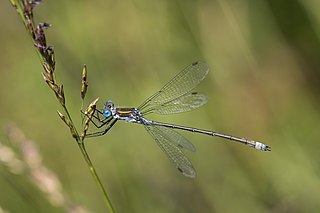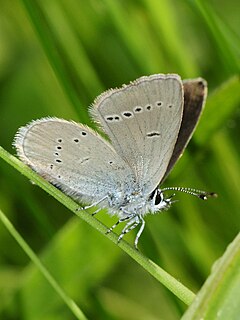 W
WDiorhabda carinulata is a species of leaf beetle known as the northern tamarisk beetle, which feeds on tamarisk trees from southern Russia and Iran to Mongolia and western China. This beetle is used in North America as a biological pest control agent against saltcedar or tamarisk, an invasive species in arid and semiarid ecosystems.
 W
WHesperia florinda is a butterfly in the family Hesperiidae (Hesperiinae). It is found in the East Palearctic in Transbaikalia to Korea, Amur, Ussuri and Japan. The larva feeds on Carex. There is a single broods. The egg hibernates. Hesperia florinda was previously a subspecies of Hesperia comma.
 W
WLestes sponsa, is a damselfly, with a wide Palaearctic distribution. It is known commonly as the emerald damselfly or common spreadwing. Both males and females have a metallic green colour and when resting its wings are usually half opened.
 W
WThe Osiris blue is a butterfly in the family Lycaenidae. It is found in South Europe, Asia Minor, southern Siberia, the Alay Mountains, Tian-Shan, Dzhungarsky Alatau, the Altai Region, the Sayan mountains, Lake Baikal and Mongolia. It is often confused with the small blue, a closely related species.
 W
WThe scarce copper is a butterfly of the family Lycaenidae.
 W
WThe small blue is a Palearctic butterfly in the family Lycaenidae. Despite its common name, it is not particularly blue. The male has some bluish suffusion at the base of its upper wings but is mostly dark brown like the female. The species can live in colonies of up to several hundred and in its caterpillar stage is cannibalistic.
 W
WXylocopa valga is a species of carpenter bee common to: western, central and southern Europe, except for far northern latitudes; the Caucasus; Middle East; Central Asia; and Mongolia. The solitary bee has a black and blue coloured body, 20–27 mm in length, and densely covered with purple hairs. The small wings also have a purple tint. The bee creates cavity nests by gnawing the wood in the trunks of dead trees and in old wooden structures. It inhabits both forests and urban areas.
 W
WXylocopa violacea, the violet carpenter bee, is the common European species of carpenter bee, and one of the largest bees in Europe. It is also native to Asia.